Introduction
Among the most serious environmental risks to metropolitan populations are air quality issues. Exposures vary by city and within cities, but all individuals living in cities are exposed to present pollution levels, damaging many as a result. Infants, small children, seniors, and those with heart and lung diseases are most vulnerable, but even young and healthy individuals can be harmed by poor air quality (Manisalidis et al., 2020). Common harmful gases in urban areas have been associated with various adverse health consequences, including cardiovascular and respiratory disorders, asthma exacerbation, premature death, and decreased lung function (U.S. Environmental Protection Agency, 2021). As a result, this research paper examines the impacts of the air quality issues on human health in the U.S., precisely, New York City.
New York City is an essential global corporate center that leads in various financial matters (Panda, 2020). The city is famous with travelers from all over the world due to its uniqueness, for instance, the New York public library ranked third largest worldwide with over fifty million books (Panda, 2020). Regardless of it being a great city, New York confronts various environmental problems like other American cities, including air pollution. Therefore, we must assess air pollution and its health effects to inform policy and enhance the city’s air quality.
Problem Statement
Clean air is one of the human necessities, yet it is polluted, leading to health issues and causing harm to the ecosystem. New York City’s citizens, wildlife, and ecosystem are all at risk from air pollution. This is because air pollution causes health problems to the residents in the city, and according to Panda (2020) air pollution accounts for more than 6 per cent of the mortality rate in New York City each year. The health problems and mortality rate of the city prompted the government to step in and assist in the problem’s resolution. The state authorities in charge of the problem, on the other hand, find the situation challenging to handle and are making every effort to solve the problem of air pollution in New York City.
As a result, the government has enacted several laws and regulations to handle the situation. The state, nongovernmental organizations, residents, and international environmental agencies have all tried to resolve the problem, with the result appearing to make positive developments on the ground. Although the authorities’ efforts appear to have worked and the situation is improving, the problem persists and demands immediate and appropriate action. Furthermore, a test conducted by the New York City community air service and the Queens College department of health found the situation disturbing. This essay will look at several elements of the air pollution problem, different types of air pollutants, and how they connect to various health issues New Yorkers face. The research from other authors will also help in the conduction of the study.
Literature Review and Hypothesis
Air Quality
Nationwide air quality rules, created by the EPA in 1971 and updated regularly based on modern science, have improved significantly (Zhongyu, 2020). Visible air quality issue is less common and extensive today than it was in the past, indicating progress. Although ozone ground-level pollution and particle pollution levels are much lower than those in ancient, they are harmful in many country regions. Air pollutants come from various sources and travel long distances and over state lines. For instance, fine particulate matter is one of the pollutants that comprise fast-travelling microscopic particles with a dimension of 2.5 micrometers or less. This substance penetrates deeply into the lungs of sentient creatures, causing various issues such as lung inflammation, which eventually damages the heart (Manisalidis et al., 2020). Several occurrences have been documented in New York City hospitals regarding the increased city’s death rate as a result of harmful air substances. The heating boilers and burning of fuels in motor vehicles are the two primary sources of this component. Nitrogen oxide is another air pollutant.
The burning of fuels in the gaseous form also produces this component. Nitrogen oxide is created when nitric oxide is released from cars or other sources, and it primarily affects the human body’s respiratory system and lungs (Zangari et al., 2020). According to scientists, this is also a factor in forming the ozone layer. Carbon monoxide is the third element (Manisalidis et al., 2020). This element is a component of the specific matter 2.5 released due to fossil fuel combustion. According to medical reports, it irritates the lungs, causes asthma and lung cancer, and harms the environment by generating heat. Another pollutant in the air is sulfur dioxide. It is produced by burning fossil fuels, primarily in industrial settings when fuel is burned on a bigger scale. According to medical specialists: it is a significant source of respiratory issues in humans, it causes acid rain and harms the ecosystem (Zangari et al., 2020). Finally, there is Ozone gas. This element is naturally present at more significant concentrations in the environment. Still, due to the incomplete burning of hydrocarbons in motor vehicles and industry, the gas enters the air and impacts the environment and human health. These air pollutants create various health issues in humans, and environmentalists and medical specialists have expressed their concerns about the matter.
Air Quality Impacts on Health
Several studies have been conducted on the impacts of air quality on health and all of them reveal that air pollution causes a range of health-related issues for humans. Individuals who are unprotected from excessive levels of polluted air acquire disease symptoms and conditions of varying severity. These health effects are categorized into two: long-term and short-term. Short-term effects include irritation of the nose, eyes, throat, and skin, coughing, wheezing, breathing difficulties, and chest tightness, together with more severe disorders like pneumonia, lung and heart problems, asthma, and bronchitis (Manisalidis et al., 2020). Polluted air can also result in dizziness, nausea, and headaches in individuals who have exposure to it for a shorter period.
Long-term exposure to pollution, which is detrimental to the respiratory systems reproductive causes’ cancer, neurological, and even death, can exacerbate these issues (Manisalidis et al., 2020). Furthermore, the toxicity of numerous air contaminants can cause lung cancer over time. According to doctors and medical specialists, the leading cause of lung cancer and respiratory disorders is fossil fuels. Inhalation of air contaminants is intimately linked to respiratory illnesses (Zhongyu, 2020).
These pollutants will penetrate the body through the nostrils and collect in the cells, causing respiratory problems such as asthma. Individuals with chronic conditions are likely to experience these long-term effects more. Additionally, voice changes can occur within a short period when the pollutants poison the trachea (Eisenman et al., 2019). Chronic obstructive lung disease can be generated by air pollution, which increases mortality and morbidity. Long-term consequences from transportation, industrial carbon emissions, and fuel combustion are the leading causes of these health and environmental issues.
Air Quality Impacts on Environment
According to environmentalists and other specialists, these pollutants are responsible for the ozone layer’s depletion (Eisenman et al., 2019). The ozone layer is depleted due to this air pollution, and most people are concerned about the long-term consequences for humans, animals, and the ecosystem. Pollutants negatively impact the environment that specialists are worried about its future condition and existence. The greenhouse effect, for example, maintains the earth’s constant temperature (Manisalidis et al., 2020). However, human activities have destroyed this temperature-controlling effect by producing large amounts of carbon dioxide (Manisalidis et al., 2020). As a result, global warming worsens, with harmful impacts to animals, human health, wildlife, agriculture, forests, and water quality.
According to Eisenman et al. (2019), global warming puts impoverished individuals’ health at risk. Individuals living in improperly designed houses in warm climate countries are at significant risk for heat-related chronic illnesses as temperatures climb. It harms the entire ecosystem because polluted air affects animals and humans and trees, soil, seas, rivers, and other freshwater bodies on the planet. Plants, like humans, are badly harmed by the detrimental effects of air pollution and agonize in their daily lives. This is contributed by increased ozone concentration in the atmosphere.
Ozone exists at both terrestrial and upper levels of the Earth’s atmosphere (stratosphere). The Sun’s dangerous ultraviolet (UV) rays are shielded by stratospheric ozone. Ground-level ozone, on the other hand, is a pollutant that is detrimental to human health (Eisenman et al., 2019). Unfortunately, ozone-depleting compounds eventually destroy the stratospheric ozone (pesticide, chemicals, and aerosols). If the protective stratospheric ozone layer thins, UV radiation reaches our planet, causing harm to humans (skin cancer) and agriculture. Ozone penetrates the pores of plants, causing them to close, preventing carbon dioxide transport and resulting in a reduction in photosynthesis. The industrialized operations in New York have also contributed to these air pollutions.
Air Quality and Industrialization
New York City utilizes more fossil fuels than any other area in its commercial and residential structures (Zhongyu, 2020). New York Metro’s buildings account for a large share of that consumption. Burning fuels for water heating and space accounts for roughly 40 per cent of the state’s total greenhouse gas (GHG) emissions in New York City. When air and water heating appliances like boilers and furnaces burn gas or oil to generate heat, they release some hazardous contaminants. Fine particulate matter (PM2.5), nitrogen and sulfur oxides (NOx and SOx), unstable organic chemicals, and ammonia are among them (Zhongyu, 2020).
Fuel-burning in businesses and homes not only exacerbates the climate issue, but it also adds significantly to bad air quality, resulting in adverse health effects and untimely mortality, particularly among people of colour (Eisenman et al., 2019). The Environmental Protection Agency (EPA) regulates ozone because of its respiratory health impacts, although ozone concentration in New York State exceeds EPA guidelines. Constructions in New York City are disproportionately responsible for this pollution, producing twice as much Nitrogen oxide as the city’s light-duty motor vehicles and seven times more than the city’s power stations. As a result, tackling building pollution is critical for the region’s overall health and air quality.
Hypothesis
According to the literature, New Yorkers are more affected by air pollution, having detrimental environmental and health consequences. Additionally, government stakeholders have been on the front lines in combating these issues and lowering the region’s air pollution rate. On the other hand, the literature does not link these air contaminants and health concerns. Furthermore, the literature does not reveal any effects on human health when the region’s air pollution improves. As a result, it is vital to determine whether or not the impacts of air pollution on human health have lessened. We examine the effects of air pollution on the health of New Yorkers using the city as an example, concentrating on two prevalent air pollutants: fine particulate matter (PM2.5) and ozone (O3). At the same time, we look at the rate of the number of asthma diseases and premature deaths concerning these pollutants, overall improvements. This will be conducted using secondary data analysis.
Methodology
Research Method and Materials
We employed a secondary data analysis as our research method. Secondary data analysis saves time and money by avoiding excessive research effort duplication. Hence, the data was taken from the Americas Health Ranking, examining the U.S. Environmental Protection Agency data. The data used estimated changes in air pollution and the number of diseases and premature deaths in a population over time. The data was collected from 2014 to 2020 to provide a wide range of comparisons. As the information was readily available on the internet, we extracted it America health ranking official website. Its ultimate goal is to enhance the well-being of the U.S. community by disseminating information that encourages individuals, health care providers, public health officials, and communities to engage and improve their environment (Manisalidis et al., 2020). The majority of its data comes from the Environmental Protection Agency (EPA).
EPA is an autonomous administrative agency within the U.S. Department charged with environmental protection. President Richard Nixon issued an executive order establishing it in December 1970 (U.S. Environmental Protection Agency, 2021). The goal of the executive order was to protect people’s and the environment’s health. Therefore, the study analyzes its air quality monitoring data to describe present air quality levels, specifies air quality conditions, such as probable declines in polluted air concentrations, and data indicating the rate of health conditions. The results are as follows:
Results
Air quality in New York City
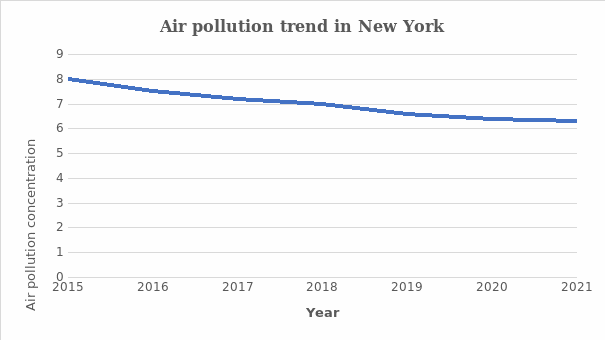
Figure 1 above shows the rate at which air pollution has decreased over time. Air pollution rates have been declining at a higher rate from 2015 to 2019. From 2019 onwards, air pollution in New York City has decreased at a significantly lower rate.
Air Pollutants Declining Percentages
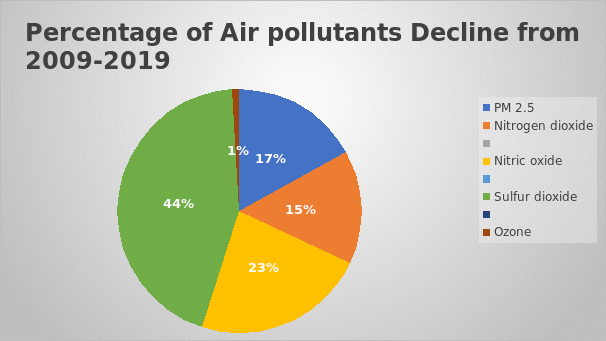
The chart above shows the decline of the air pollutants converted to 100%. Annual average levels of PM 2.5 declined by 17%, nitrogen dioxide by 15%, nitric oxide by 23%, Sulfur dioxide by 44%, and average ozone levels decreased by 1%.
Specific Pollutants Decline Trends
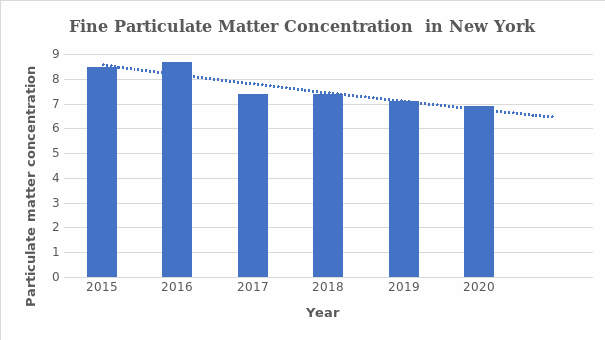
The graph above shows the annual average of the particulate mate over the years. The trend line indicates the concentration has been decreasing. From 2015 to 2016, the average concentration in the atmosphere increased. From 2016 onwards, there was a decrease in the concentration of particles in the air but at a lower rate.
Ozone Concentration
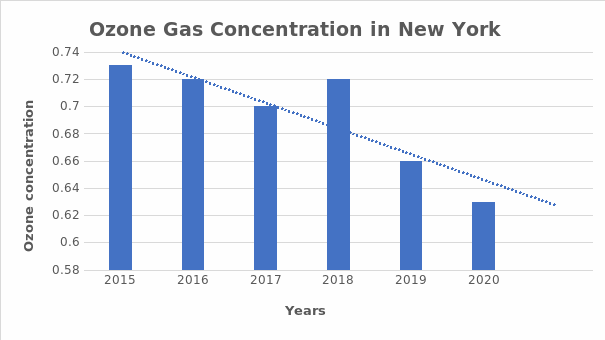
The graph above shows the annual average concentration of ozone gas over the years. The trend line indicated the concentration has been decreasing. From 2015 to 2017, there has been a decrease in ozone concentration in the atmosphere. 2017 to 2018 shows an increase in concentration, but from 2018 onwards, the ozone gas concentration has a decreasing trend.
Asthma Trend
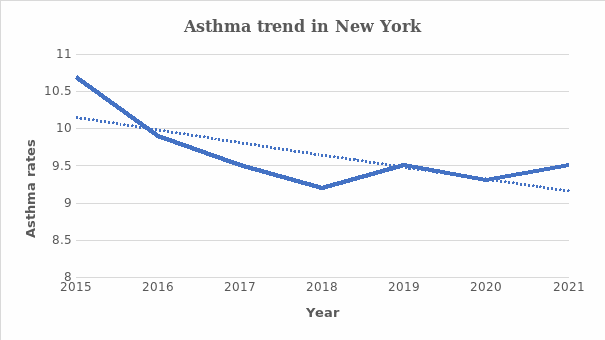
The graph shows the trend of asthma disease over the years among adults and children. There was a drastic decrease in asthma rates from 2015 to 2018. From 2018 to 2019, an increase is seen, while towards 2020, the rates decrease.2020 to 2021 shows an increase in asthma rates.
Premature Death
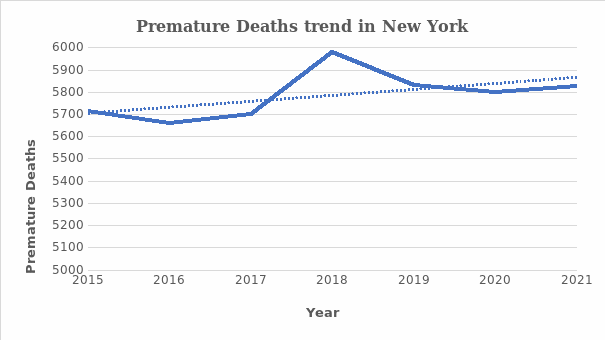
The graph above shows the trend of premature death rates over the years. According to the trend line, it indicates early death rates have been increasing. From 2010 to 2017, there was a decrease in the death rates than an increase. Afterwards, 2017 to 2019 shows a drastic increase in premature death rates than a decrease. After that, from 2019, it has been increasing at a lower rate.
Comparisons Estimates between Air Pollutants and Health Effects
Figure 7: Comparisons estimates between air pollutants and health effects in New York
The table above shows the summary and comparison of the two air pollutants and the health problems trends associated with New Yorkers. PM 2.5, Ozone levels, and Asthma rates have a declining tendency in most parts of the year. On the other hand, premature death rates have an increasing trend in most parts of the year.
Data Analysis and Discussion
Analysis
New York’s air pollution level has significantly decreased. We can observe from Figure 1 that the rate of air pollution in the city’s atmosphere is reducing. This is because of the steps put in place to help minimize the air quality issues that have caused so much disruption in the past. The percentages of specific air pollutants dropping at a faster rate in New York demonstrate a positive trend. Figure 2 shows that annual average levels of fine particulate matter (PM 2.5), nitrogen dioxide, and nitric oxide have decreased by 38 per cent, 33 per cent, and 52 per cent, respectively, when expressed in actual percentages. Sulfur dioxide has seen the most reductions, owing primarily to local and state heating oil laws. As a result, the average wintertime levels fell by 97 per cent. Average ozone levels throughout the summer have remained steady (U.S. Environmental Protection Agency, 2021).
Figure 3 shows that PM 2.5 has been falling for most of the years, indicating a 38 per cent decrease. However, this is analogous to the falling trend in Ozone gas concentrations at a much slower rate. According to Americas Health Ranking statistics, this is due to its average yearly number of days exceeding regulatory guidelines remaining constant. Even though air pollutants are reducing, they still impact New Yorkers’ health, albeit at a lower rate for some of their health concerns. Figure 5 illustrates, for example, that the rate of asthma infection has been declining for the majority of the years. This is because EPA air quality statistics show a decrease in the rate of air pollution. On the other hand, premature death rates showed an increasing tendency, albeit at a lower rate in figure 6.
Premature death is the number of years of potential life lost before 75 years. New Yorkers have been inhaling poisonous fumes for years due to air pollution particles in the environment, contributing to early death rates. On the other hand, deaths at younger ages contributed more towards the premature death rate than deaths after the age of 75 (U.S. Environmental Protection Agency, 2021). As a result, according to the study’s findings, there is a link between air quality and health concerns among New Yorkers. As the concentration of air pollutants decreases, asthma rates decrease, and premature rates increase at a slower pace. As a result, New Yorkers are still at risk of developing health problems due to PM2.5 and ozone levels in the air.
Discussions
Although there is significant scientific evidence for the negative impacts of PM2.5 and ozone, studies do not clearly express the magnitudes of the air quality issues to public health or how it associates with other challenges the city is facing. In this research, we utilize methods used by America’s Health Rankings and Environment Protection Agency to assess air pollution risks and control measures benefits. After that, we combine with New York City health problems data to reflect their wide disparities in health and vulnerability to air pollution effects. The obtained figures more accurately represent the city’s substantial total load of air pollution and its spread throughout the city, which negatively impacts asthma and premature deaths.
Specifically, the problem of air pollution has been blamed for the premature deaths of several people in New York (Panda, 2020). Typically, air pollution happens when the sun collides with emissions from factories, vehicles, and other fuel-burning activities. Many New Yorkers suffer from cancer, asthma, and other health problems due to pollution. Air pollution is responsible for over 6% of all deaths in New York each year. According to the findings, there is a direct link between air pollution and New Yorkers’ health concerns. As air pollution levels decrease, asthma rates drop, and premature death rates increase at a slower pace. We can also find this relationship in reports from other health departments and authors.
According to the New York Health Department, PM2.5 contamination causes more than 2,000 hospital admissions for heart and lung diseases, 3,000 fatalities, and 6,000 hospital visits for asthma in adults and children each year (Eisenman et al., 2019). A 10 per cent reduction in present PM2.5 levels might avert more than 200 hospital admissions, 300 premature deaths, 600 emergency room visits per year and improve the city’s air quality. Zhongyu (2020) also show the association in the study of daily ozone concentrations vs daily death rates. An observed rise in ozone levels was associated with an increased day-to-day number of fatalities by 0.33%, the number of pulmonary deaths by 1.13%, and the number of stroke cases by 1.13% throughout the year’s warm season. He concluded that ozone-related mortality would reduce if we followed only climate change and present legislation. Additionally, we can avert over 300,000 premature fatalities due to a reduction in ozone concentration in the optimistic outcome of maximum technologically achievable emission reductions (Zhongyu, 2020). How improved air quality has reduced the prevalence of health problems among New Yorkers support this, but much more has to be done.
This concern is because, whereas the air quality of the city has improved in recent years, air pollution still accounts for (about) 6% of the city’s deaths annually, rendering it one of the state’s most serious environmental health issues. Furthermore, improvements in pollution levels among modern local programs will have large and significant health benefits only if the residents decrease their smoking rates. To lessen the toll of air pollution, actions are required to address critical local air pollutant sources, such as building heating oil, vehicle exhaust, and power stations with outdated technology. Many carbon reduction measures have begun as part of the city’s strategic framework. These measures will have other benefits in addition to health, such as lowering greenhouse gas emissions. However, investments and behavioral changes are also required, so New Yorkers must understand the impact of air pollution on their health, the health advantages of addressing it, and the consequences of inaction.
System Conceptual Framework
This air pollutants concentration and its health-related effects have ramifications for the economy, the environment, and the government. For instance, it reduces sight and blocks sunshine. Particulate pollutants from all sorts of burning limit the amount of sunlight reaching the surface and even alters the sky’s appearance (Eisenman et al. (2019). Forests grow more slowly, and crops produce less when less sunlight is sufficient for photosynthesis. The weather and the climate are affected by a hazy sky and restricting visibility. Furthermore, it causes acid rain and harms forests, agriculture, and wildlife. This air pollution also causes health-related issues which impacts the economy.
In terms of the economy, air pollution impairs people’s capacity to work. Having asthma or other chronic respiratory disorders limits one’s aptitude to work and affects labor force contribution (McCarthy, 2020). Asthmatic children skip school, which impacts their development, and their parents may need to take extra time away from work to attend for them. This lowers the country’s labor productivity, which has economic consequences in the long run.
As a result, improved enforcement of existing policies and regulations and more extensive monitoring are required to enhance air quality (U.S. Environmental Protection Agency, 2021). However, putting all of this in place will cost the government money hiring experts to monitor air quality levels and incentivizing businesses to adopt new technical equipment that emits fewer pollutants during production. Additionally, because of the health implications of these air pollutants, more people are being admitted to hospitals for respiratory problems, including asthma. This means that the government will be responsible for these costs. Despite this, the government has been able to keep air pollution under control and has made significant progress toward meeting national air quality criteria. However, these contaminants are hazardous to public health and welfare even at deficient levels. As a result, further measures are required.
Conclusion and Recommendation
Conclusion
Following a detailed examination of the study mentioned above, it is evident that the state of air quality in New York is not favorable. More significant efforts and education are needed to address the issue. Clean air is essential for the survival of animals, humans, and the planet itself. If New Yorkers ignore the problem, they will face severe difficulties. Government officials, as well as citizens, should work on improving the situation. Authorities and citizens have taken a lot of initiatives to address the problem. While the situation has improved, the issue remains unsolved, and efforts should continue in the correct direction. This will aid in the promotion of environmentally friendly behavior.
Recommendation
New York City can utilize customized messages to target specific populations to promote healthy environmental behavior. New York will be compelled to research to generate messages that will prevent citizens from polluting the air by targeting particular messages to intended audiences. While New York organizers may be firm believers in using public or bicycle transportation rather than private transport for commuting to work, the intended audience may hold a different viewpoint. Although riding a bicycle or public transit cuts pollution, organizers must consider New Yorkers’ perceptions. Before sending out, any communications, campaign organizers should perform a comprehensive study to understand the perceptions and values of New Yorkers. Residents will be motivated to maintain their environment if their messages are delivered correctly.
Furthermore, fostering a sense of commitment among New York City residents might encourage healthy environmental behavior. This can be accomplished by campaign organizers engaging in activities that urge New Yorkers to be dedicated to ecological preservation. This entails being on the front lines to execute efforts to reduce air pollution. People are more likely to react positively to what leaders do than what they say. As a result, it is up to the organizers to back up their statements with deeds. Preaching one thing and doing another can be disappointing, and it shows a lack of authenticity on the part of activists.
References
Eisenman, T. S., Churkina, G., Jariwala, S. P., Kumar, P., Lovasi, G. S., Pataki, D. E.,… & Whitlow, T. H. (2019). Urban trees, air quality, and asthma: An interdisciplinary review. Landscape and urban planning, 187, 47-59.
Manisalidis, I., Stavropoulou, E., Stavropoulos, A., & Bezirtzoglou, E. (2020). Environmental and health impacts of air pollution: a review. Frontiers in public health, 14.
McCarthy, N. (2020). This is the global economic cost of air pollution. World Economic Forum. Web.
Panda, I. (2020). New York City Air Pollution Problem – 1394 Words | Essay Example. Free Essays. Web.
U.S. Environmental Protection Agency. (2021). U.S. Environmental Protection Agency | US EPA. US EPA. Web.
Zangari, S., Hill, D. T., Charette, A. T., & Mirowsky, J. E. (2020). Air quality changes in New York City during the COVID-19 pandemic. Science of the Total Environment, 742, 140496.
Zhongyu, M. (2020). Air pollution and adverse health effects: Assessing exposure windows and sensitivity to modelling choices. Academic Commons. Web.